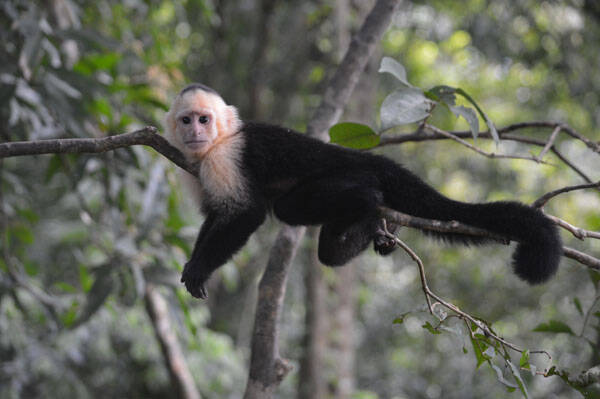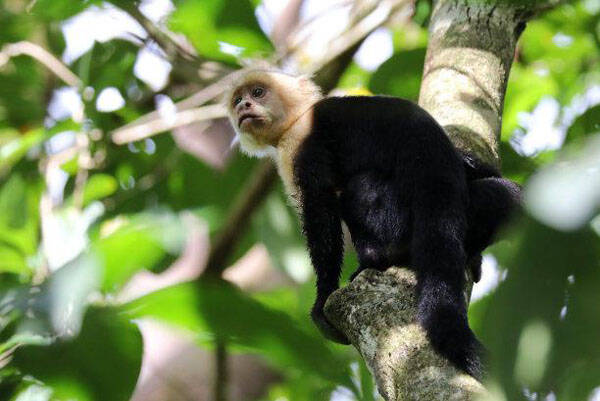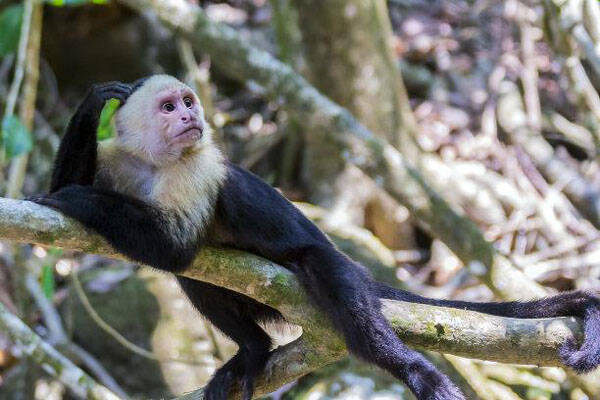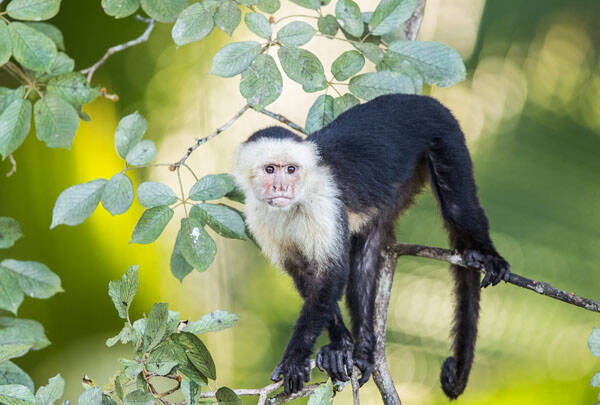Cebus capucinus
IUCN
LCBasic Information
Scientific classification
- name:Cebus capucinus
- Scientific Name:Cebus capucinus, Colombian White-throated Capuchin、 White-faced Capuchin、White-headed Capuchin、 White-throated Capuchin,Sapajou capucin, Capuchino de Cara Blanca de Colombia,Weißschulter-Kapuzineraffe
- Outline:Primates
- Family:C.monkeys
Vital signs
- length:About 43.5 cm
- Weight:2-4kg
- lifetime:25-50years
Feature
The back and hindquarters are solid black, the cheek skin is tan, and the head is covered with a black cap.
Distribution and Habitat
The white-faced capuchin monkey is native to the Central American Neotropics. It is found along the coasts of Honduras, Nicaragua, Costa Rica, Panama, and Ecuador, as well as the Colombian island of Gorgona. Some individuals have been reported as far south as Argentina. The species is one of the most widely distributed of all New World monkeys.
The white-faced capuchin monkey is highly adaptable and has a wide range of habitats. They live in a variety of moist, dry, primary, and secondary forests, but prefer tropical evergreen and dry deciduous forests. They prefer lush, dense forests up to 2,100 meters, but mainly occupy the mid-story around 1,100 meters. The species is common in lowland areas with high humidity and good drainage. It is occasionally seen in volcanic foothills and coastal plains.
Appearance
White-faced Capuchin monkeys weigh between 3-4 kg for males and 2-3 kg for females. This is the greatest degree of sexual dimorphism among the Capuchins. The species has unique markings that distinguish them from other Capuchins. Their back and hindquarters are solid black, while the fur on the upper chest, forearms, and around the face is white. The cheek skin is tan in color, and they have a black cap on their head. They have a prehensile tail that is used for grasping and carrying food and for added postural support. The species reaches its adult size at the age of 8 years. They are primarily quadrupedal animals, but are also excellent jumpers and climbers.
Details
White-faced Capuchin (scientific name: Cebus capucinus) English Colombian White-throated Capuchin, White-faced Capuchin, White-headed Capuchin, White-throated Capuchin, French Sapajou capucin, Spanish Capuchino de Cara Blanca de Colombia, German Weißschulter-Kapuzineraffe, there are 2 subspecies.

The habitat of the white-faced capuchin monkey is about 80 hectares or 0.8 square kilometers. They have a strong sense of territory and will defend their territory from other capuchins. When an intruder is noticed, an individual will sound the alarm and the group will flee or swarm to attack the intruder.
White-faced capuchins are a highly social species, and communication is very important. Individuals spend a lot of time forming social bonds and building trust. For example, in hand sniffing, one monkey will stick its finger into the nose of another monkey, and the other monkey will then repeat the activity. This can last for several minutes and is done with a trance-like expression. They may also suck each other's fingers and tails for a long time. White-faced capuchins also play mouth games, where one monkey will insert something in its mouth, whether it is another monkey's finger, a piece of fur, or some inanimate object. The object of this game is to pry the object out of someone else's mouth and then put the object back in the mouth to start a new game, or they take turns swapping roles. White-faced capuchins use trilled vocalizations to coordinate the group's movements when a predator approaches. Different alarm calls are used to alert other monkeys that a predator or intruder is nearby.

White-faced capuchins live in multi-male and multi-female groups of 18-20 individuals. Males leave around 4 years old to find a place in a new group. These diurnal primates are very active during the day and sleep at night. They are playful and curious, play and play a wide range of content, and are particularly interested in taking things apart. This behavior is more common in captivity, but also occurs in the wild. White-faced capuchins are energetic and active. Social play is common among all group members, especially adolescents, who spend a lot of time playing and wrestling. Adolescents also rely heavily on social learning; observing adults to learn basic behaviors and skills.
White-faced capuchins eat a wide variety of plants and animals. The main diet is a variety of fruits and nuts, but insects, other invertebrates, and small vertebrates are also frequently ingested. Vertebrates eaten include squirrels, tree mice, lizards, and birds. The diet varies by region and season, but is generally composed of about 50%-80% fruit, 20%-30% animal food, and 10% other plant food. They are always eating and are adventurous in their food choices, trying almost everything and learning what is edible or desirable through trial and error. One study showed that white-faced capuchins ate 63 different plant species from 34 families in Santa Rosa Park. They are excellent foragers from an early age. At just one year old, they can forage for food almost as well as adults, with the only limitations being size and strength.

The most common predators of the white-faced capuchin are snakes, especially Corallus and Bothrops, caimans, cats such as jaguars and ocelots, and large birds of prey such as harpy eagles. White-faced capuchins make alarm calls when they spot a predator. Living in tight social groups helps them stay alert to predators. Groups threatened by predators either flee or mob the predator.
White-faced capuchins are polygamous, with both males and females having multiple partners. There is a dominance hierarchy between males, with alpha males having more opportunities to mate. However, subordinate males can also mate. Alpha males spend most of their time deterring predators and males from outside groups. Providing this protection for their own group gives alpha males priority over other males in terms of mating opportunities. Males and females perform a series of specific vocalizations, facial expressions, and postures before mating. Females give birth to one offspring approximately every 2 years. Reproduction is seasonal, with peak fertility between January and April. Mating can also occur outside these months, but rarely results in conception. The gestation period lasts an average of 160 days.
Adult females become sexually mature around 4 years old, but usually do not give birth until 7 years old. Males become sexually mature at 7-10 years old. Primary care of infants is provided by the mother. Females carry, protect, and feed the infants until they are able to take care of themselves. Males do not help care for infants, but once infants are grown and independent, males help other young white-faced capuchins in the social hierarchy. Alpha males help protect members of their group from intruders and predators.

The maximum lifespan of a white-faced capuchin monkey in captivity is 55 years. In the wild, lifespan may be less than half that. Factors such as predation, disease, and infection of wounds from combat kill many monkeys each year. Tree felling, logging, and felling are the main indirect causes of death for white-faced capuchins because they significantly reduce suitable habitat. The species population has declined by 30% or more within three generations due to habitat degradation and the pet trade.
Listed in the IUCN Red List of Threatened Species in 2020 ver3.1 - Vulnerable (VU).
Listed in Appendix I, II and III of the Convention on International Trade in Endangered Species of Wild Fauna and Flora (CITES) 2019 edition Appendix II.
Protect wild animals and eliminate game.
Maintaining ecological balance is everyone's responsibility!








